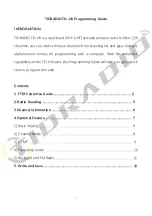
SMARTNET/SMARTZONE/P25 TRUNKED FEATURES
50
attempt communication on another system or by some
other means.
6.14.7 P25 WIDE AREA SCAN
Introduction
This feature is intended to enhance roaming
performance, especially when system level steering
via radio or talk group permissions is used.
Normal P25 and SmartZone Control Channel Hunt
The following control channel search methods are
normally used to find a control channel:
Short Hunt -
The dynamic array of 7 (or 15) adja-
cent sites is searched. This list is saved on power
down and loaded again at power up. It is erased
whenever parameters are downloaded to the radio
by the PCConfigure programmer.
Long Hunt -
If no valid control channel is located
by the preceding short hunt method, the radio
searches the list of control channels programmed
into the radio by the PCConfigure programmer.
Full Spectrum CC Scan -
If the two preceding
methods do not locate a control channel, every
channel available to the radio is searched.
Talkgroup Steering Via System Access Permissions
In order to use system channel resources more
efficiently, some system operators are using system
access permissions to steer certain talkgroups to
particular sites. For example, a police department may
be allowed to use only Site 1, and a public works
department may be allowed to use only Site 2.
The problem with this operation is that every time
a different talk group is selected, the access permission
may be different and a different site may need to be
accessed. This could result, in a worst case, in a delay
of up to 30 seconds in finding a new site. This could
occur if there are no valid sites for the new talk group
in the dynamic site list.
P25 Wide Area Scan
A feature called Wide Area Scan can be
programmed to minimize the problem just outlined.
This feature is programmed on the Talk Group list
screen selected on the P25 System screen. When Wide
Area Scan is selected, talk group site preferences are
no longer available. However, System Site Preference
lists can still be used. The Wide Area Scan feature
functions as follows:
1. Assume TG1 is selected. If it is the first time this
talk group is selected, normal searching for a control
channel occurs according to the hunt methods
previously described.
2. When another talk group is selected, the active valid
site for TG1 is stored in EEPROM memory.
3. The next time TG1 is selected, the following proce-
dure is performed before performing the normal
hunt methods previously described.
a. The last valid site ID and its receive and transmit
channel numbers are loaded from EEPROM
memory.
b. The dynamic site list is checked to see if any
newer receive/transmit channel information is
available for the last site ID.
c. The best receive/transmit information is used and
the radio checks to see if this control channel is
available.
The result of the preceding operation is that the
radio has a reasonable chance of finding a valid site,
usually on the first try. This greatly reduces access
time, even on systems which have highly restricted
talk group based access.
















































